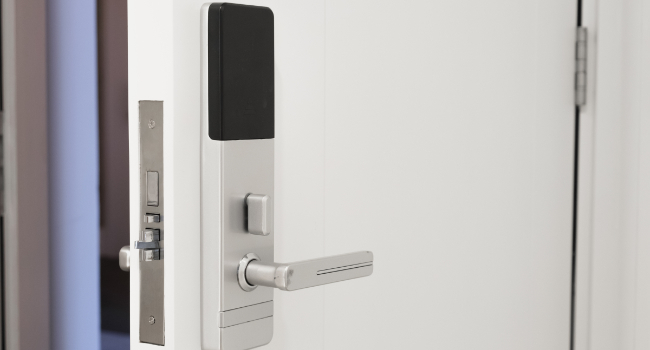
Meeting Modern Demands
- By Benjamin Williams
- Mar 12, 2025
Door hardware and access control continue to be at the forefront of innovation within the security industry, continuously evolving to meet the dynamic needs of commercial spaces.
From ensuring robust security to simplifying complex installations, advancements in electric strikes, electromagnetic locks (maglocks) and specialty solutions are addressing the unique challenges of securing modern openings.
Evolution of Commercial Doors and Security
Modern commercial doors span a wide range of applications—swinging, sliding, folding and glass—all requiring customized access control solutions. This diversity has spurred a shift from traditional hardware to advanced electronics and integrated systems. These networked solutions connect to access control software platforms, providing real-time updates, dynamic monitoring, and seamless control through a centralized interface.
Alongside enhanced functionality, sustainability remains a priority, with more manufacturers incorporating lower power energy-efficient design strategies to align with green building standards.
Re-envisioning Retrofit
Retrofitting an opening is more economically efficient and a less carbon-intensive way of upgrading outdated buildings than demolition and rebuilding according to the Net Zero Carbon Guide, and some 80 percent of the buildings standing in the year 2050 will be already built. To address the growing retrofit market, entrance solutions now include new wireless devices integrated to door control and part of larger, online networked solutions.
Wireless locks, readers and electronics are increasingly reliable with longer signalling range, quick transmission and encrypted communications. These devices solve challenging installations like historic buildings or concrete structures where drilling is prohibited or too time consuming – while delivering robust, secure openings.
Electric Strikes: Versatile and Efficient
Electric strikes remain the most common method for adding access control to the opening. They offer dynamic functionality with exceptional security, providing greater flexibility for installers that allows them to use these types of solutions for the most complex all-glass door openings.
More advanced models provide integrated monitoring capabilities, enabling real-time feedback on door status and improving access control management. These devices continue to be refined to provide more flexible installation and programming features that shave off installation time in the field, making projects more profitable. Easy to install, electric strikes reduce labor costs and field time onsite, making them the preferred choice for installers and systems integrators alike.
Maglocks: Strength Meets Innovation
Maglocks have long been valued for their durability and simplicity, with no moving parts to wear down over time. Recent innovations have enhanced their functionality with features like built-in motion sensors and tamper detection. These advancements reduce wiring complexity, making installations quicker and cleaner.
Eco-friendly maglocks dramatically lower energy consumption, supporting green initiatives while maintaining high holding force and security.
For example, built-in door prop sensing technology de-energizes the maglock when the door is in an open position for a predetermined period, alerting users and throttling down power draw to save energy. Maglocks now include a wide range of configurations and programming options, as well as new styles and finishes to meet architectural designs. In addition to smaller maglock footprints for unobtrusive aesthetics, these devices connect to an entrance access control or building management system for live status updates on the opening.
Specialty Locks: Securing Gates and Cabinets with Innovation
In recent years, gates have become the first layer of defense in physical security design strategies and increasingly deployed in interior spaces like warehouses and data centers.
Electronic gate locks make installation easier by integrating advanced features, such as automatic dual voltage adjustment, latch monitoring and fail-safe or fail-secure options, ensuring flexibility and robust security.
These locks provide solutions for diverse applications, from residential pools to critical infrastructure, combining durability with compatibility for electronic access control. For example, gate locks with latch status monitoring can be integrated with a larger access control or building management software for real-time status that indicates the gate is closed and the latch strike is engaged and secure. Installer-friendly designs make upgrades seamless, while options like shock-absorbing mounts and wireless components reduce labor and extend hardware life.
Addressing the growth in data centers – driven by AI and information demands and the need to protect assets and information – are specialty server cabinet locks. These devices give users higher levels of security and accountability – with an audit trail at the cabinet level or configured as part of a networked access control solution.
The access control market continues to adapt to the evolving needs of modern facilities and every level of security. Innovations in electric strikes, maglocks and related technologies continue to raise the bar in security, efficiency and sustainability. As these solutions become more integrated and intelligent, they are ensuring that the buildings of today are prepared for the challenges of tomorrow.
This article originally appeared in the March / April 2025 issue of Security Today.